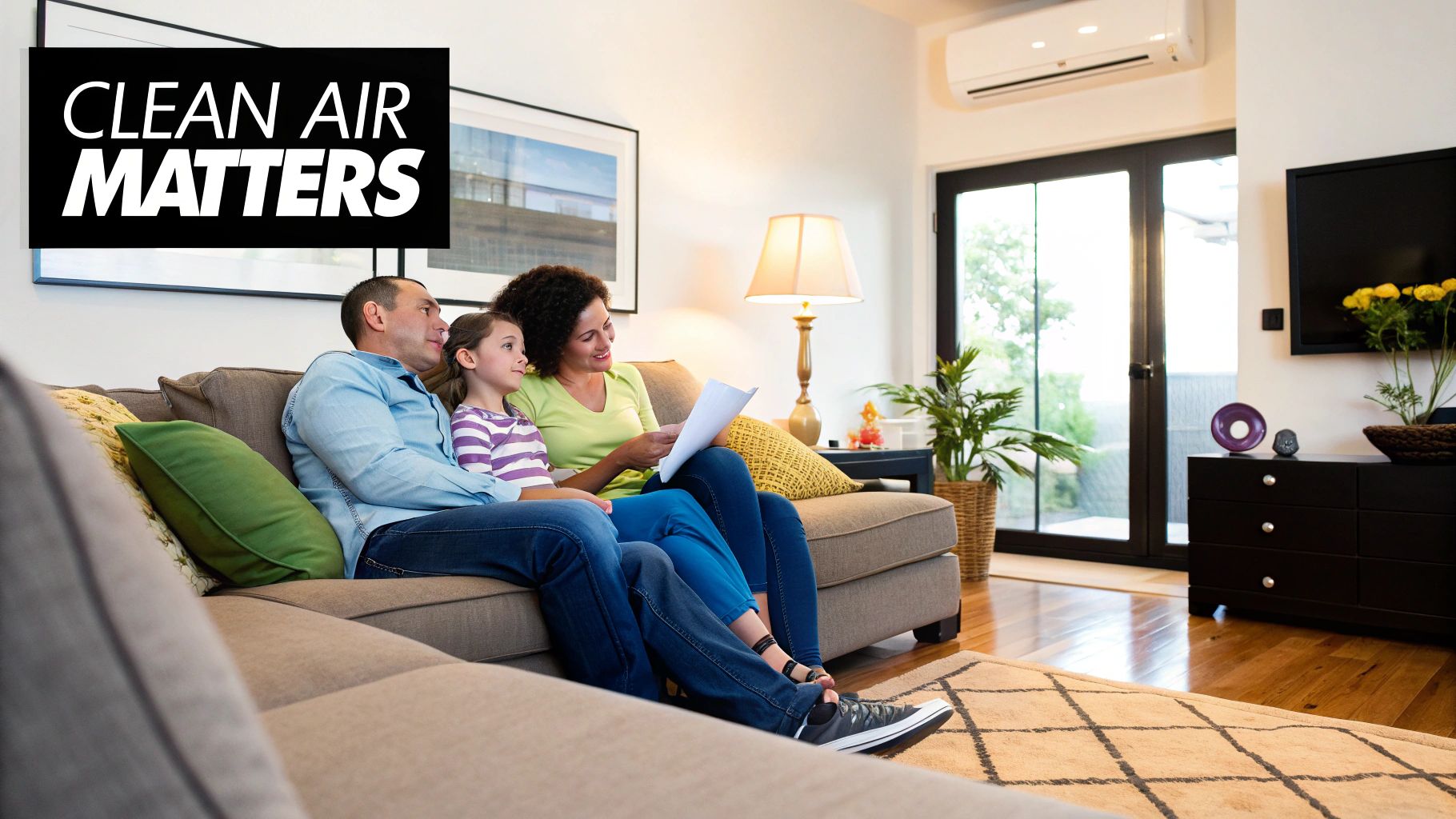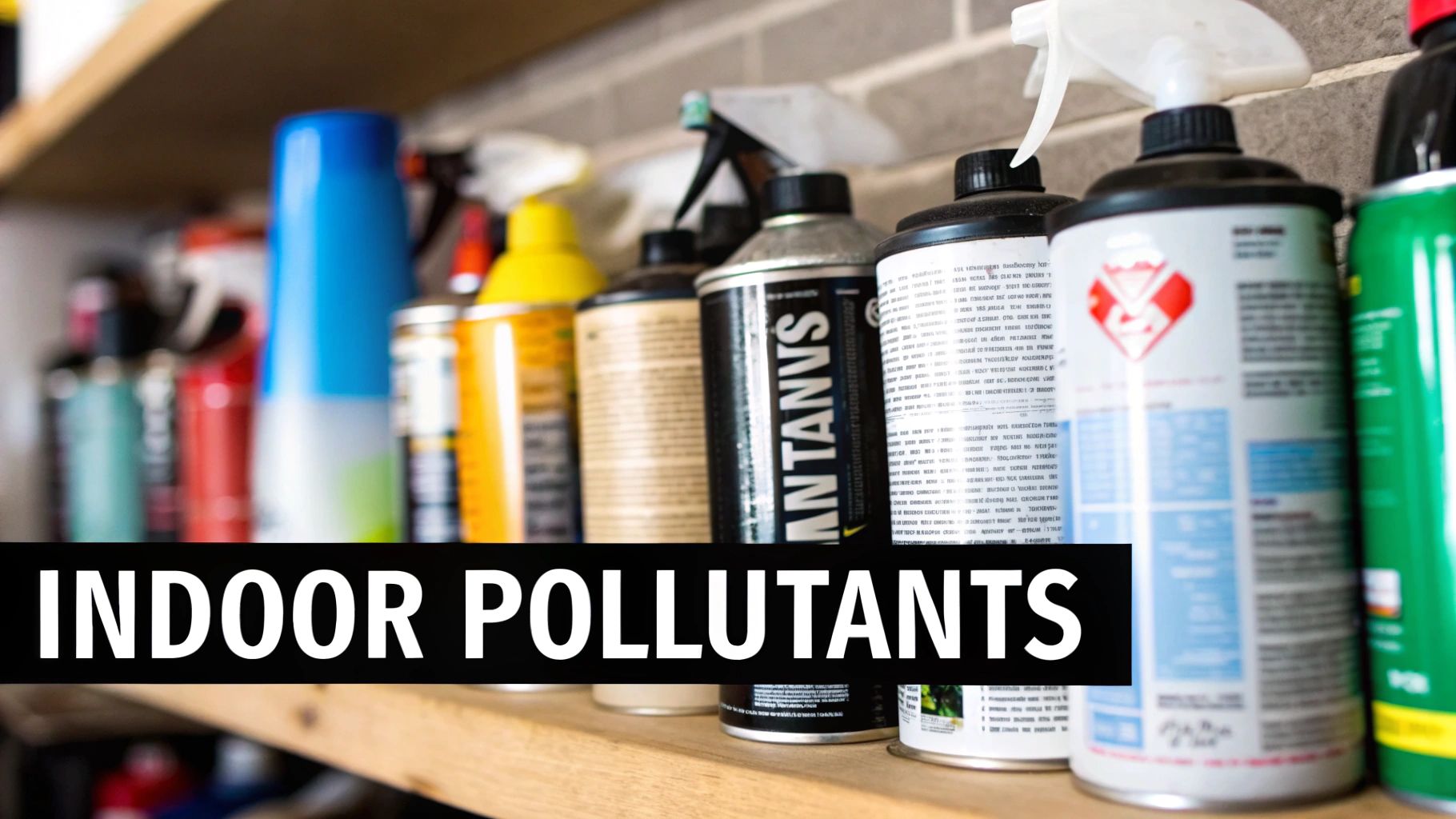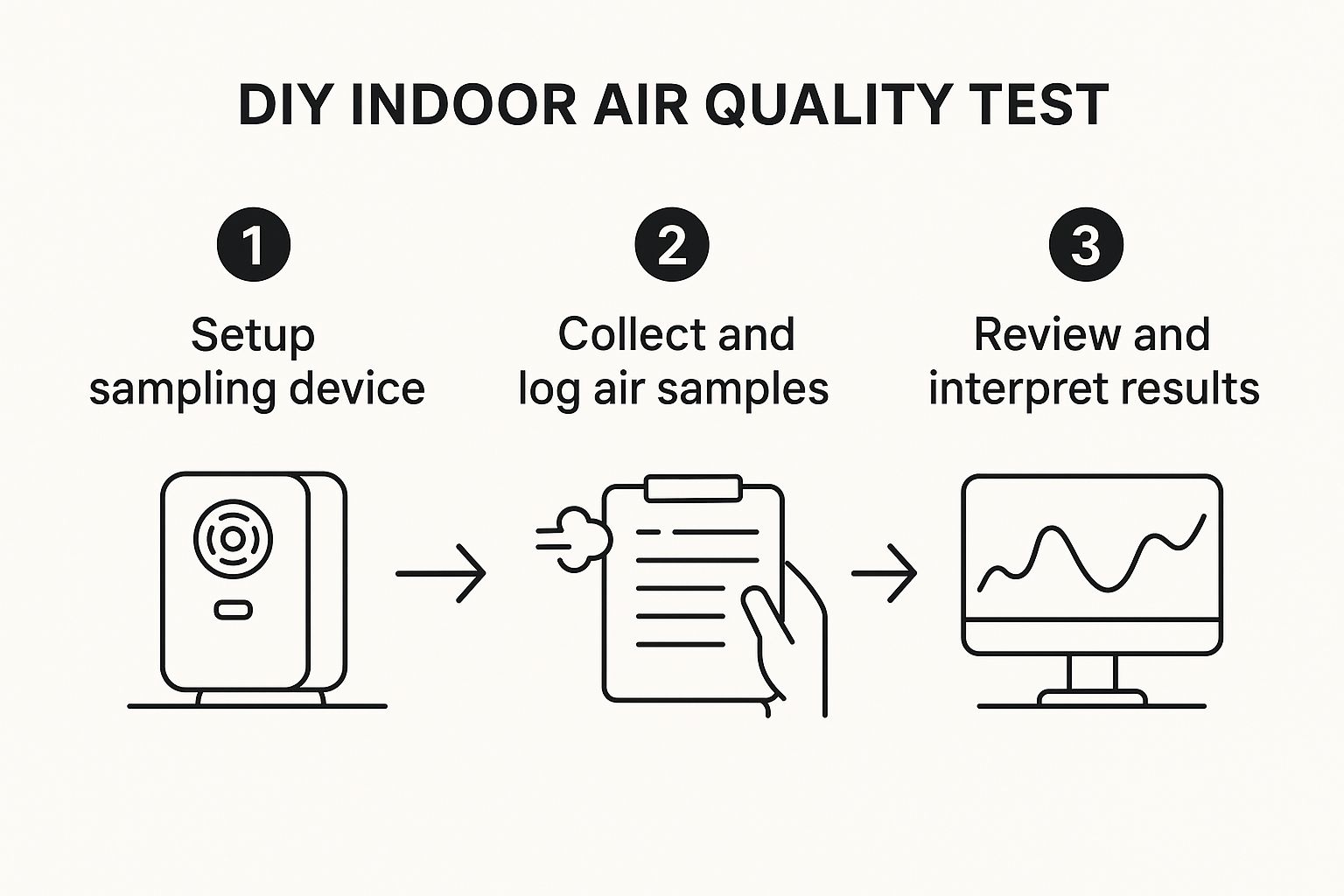Indoor Air Quality Assessment: Improve Your Home’s Air Now
- shawnpurifiedair
- Jul 25
- 13 min read
An indoor air quality assessment is the first, most critical step you can take to understand what's really going on with the air inside your home or building. It’s a process of identifying and measuring potential pollutants, not just for peace of mind, but to create a genuinely healthier living or working space. Think of it as the foundation for turning your home into a true sanctuary.
Why Your Indoor Air Quality Matters

Here’s a fact that always surprises people: we spend up to 90% of our lives indoors. What’s more shocking is that the air inside our homes and offices can be significantly more polluted than the air outside. An indoor air quality assessment is no longer just a "nice-to-have"; it's an essential tool for maintaining a healthy home.
The biggest culprits are often our everyday activities. Cooking dinner, using standard cleaning products, or even lighting a scented candle can release a whole cocktail of pollutants into the air. These particles and gases get trapped and accumulate, especially in modern, energy-efficient homes that are sealed up tight.
Unseen Risks from Everyday Life
The link between our indoor spaces and our health is impossible to ignore. Scientific research now links indoor air pollution to an estimated 3.2 million premature deaths worldwide each year. It's a sobering number that underscores the serious risks from exposures happening right where we live and work. You can get a deeper understanding of this global health priority by seeing how everyday actions contribute to these statistics on weforum.org.
Airborne pollutants, like fine particulate matter and volatile organic compounds (VOCs), can either trigger or worsen a long list of health issues. For facility managers, poor air quality often translates to lower productivity and complaints of "sick building syndrome." For homeowners, it can impact the well-being of the entire family.
Key health concerns I see tied to poor IAQ all the time include:
Respiratory Issues: Worsening symptoms for anyone with asthma and allergies.
Irritation: That nagging eye, nose, and throat irritation that you just can't seem to pinpoint.
Long-Term Effects: Serious conditions that can develop from prolonged exposure to silent threats like radon or hidden mold.
A systematic indoor air quality assessment moves you beyond the guessing game. It gives you clear, data-driven answers about what’s actually in your air, so you can take targeted, effective action.
Taking Control with a Proper Assessment
Knowing the specific threats in your air is the only way to create a truly safer environment. A detailed assessment helps you pinpoint the exact sources of contamination. For example, is that persistent musty odor just an old basement smell, or is it hidden mold growth? Are those frequent headaches from stress, or are they from high CO2 levels due to poor ventilation?
Once you identify the real issues, you can invest in solutions that work instead of wasting money on generic air fresheners or purifiers that don't address the root cause. An assessment is your roadmap. It guides you toward targeted actions that make a genuine difference in protecting your family’s health and well-being. It is, without a doubt, the foundation for a healthier home.
How to Spot Invisible Threats in Your Home

Before you even think about buying a single test kit, your first indoor air quality assessment begins with the best tools you already own: your senses. It's about becoming a detective in your own home, and you can uncover a surprising number of clues this way. The most common signals, smells, physical sensations, recurring health symptoms, are often the most overlooked.
I can't tell you how many homeowners I've spoken with who've gotten used to a faint musty smell in the basement or a stuffy feeling in an upstairs bedroom. They chalk it up to the house just being old, but these are classic red flags. That musty odor almost always points to hidden mold or mildew, which loves to grow in damp, dark places.
And that stuffy room? It's likely a sign of poor ventilation. When air doesn't circulate properly, it allows carbon dioxide and other pollutants to build up. Trusting these gut feelings and sensory clues is your most powerful and cost-effective first move.
Conducting Your Walk-Through Inspection
Set aside a bit of time to do a dedicated walk-through of your property. Don't just wander around; be methodical. Go from room to room with the sole purpose of looking, smelling, and feeling for anything out of the ordinary. This process helps you build a strong hypothesis before spending a dime on testing.
Ask yourself: what's changed recently? Did you just have new carpet laid down or assemble some flat-pack furniture? These common household items can release volatile organic compounds (VOCs) into your air for weeks, even months, in a process called off-gassing. If those new headaches or scratchy throats started right after the new furniture arrived, VOCs are a prime suspect.
Your body is often the most sensitive air quality monitor you have. If your allergy or asthma symptoms consistently worsen in a specific area of your house, that’s a powerful piece of evidence pointing to a localized pollutant source.
A Practical Checklist For Your Assessment
To give your inspection some structure, run through a few key questions. Answering them will help you zero in on potential problems and make sure any future testing is targeted and effective. For an even deeper dive, our guide on **how to tell if your home or business has poor indoor air quality** has some extra insights you might find helpful.
The goal here is to connect the dots between your symptoms and their potential sources. This detective work makes your formal indoor air quality assessment far more successful.
Sensory and Health Checklist
Persistent Odors: Are there any lingering musty, chemical, or stale smells? Pay close attention to basements, bathrooms, and closets.
Visible Signs: Can you spot any water stains on ceilings or walls, condensation on the inside of windows, or visible mold growth?
Allergy Flare-Ups: Do you or your family members find that allergy or asthma symptoms act up at home but get better when you're out?
Stuffy Air: Does the air in certain rooms feel heavy, stagnant, or just plain stale compared to other parts of the house?
Combustion Sources: Do you have gas appliances, like a stove, furnace, or fireplace? Without perfect ventilation, invisible gases like carbon monoxide can build up.
By methodically working through these points, you transform a vague hunch into a concrete list of possibilities. This preliminary legwork ensures that when you do decide to use monitors or test kits, you aren't just taking shots in the dark. You’re strategically confirming your suspicions.
Choosing the Right Air Quality Assessment Tools
Trying to figure out which air quality test to buy can feel overwhelming. I get it. The market is flooded with options. But picking the right tool for your indoor air quality assessment really comes down to one question: are you trying to solve a specific, nagging problem, or are you looking for the big picture of your home's overall health?
Your choice will likely fall into one of two camps: single-use test kits or real-time electronic monitors. They each have their place, and knowing when to use which is the key to getting answers without wasting money.
Single-Use Kits for Specific Threats
Think of single-use kits as your specialists. You bring them in when you have a strong hunch about a particular culprit. Maybe there's a musty smell in the basement you just can't shake, or you're living in an older home and radon is a legitimate concern. This is where these targeted tests shine.
They're usually inexpensive and dead simple to use. The most common ones you'll see are:
Mold Test Kits: These typically use a petri dish to collect airborne spores or a direct swab for visible spots. They’re great for a quick "yes" or "no" on the presence of mold, but you'll usually need a lab analysis (often for an extra fee) to find out the type and how much is there.
Radon Test Kits: Radon is a silent threat, an odorless, invisible gas that poses a serious health risk. A simple test kit, whether it's a short-term one (2-7 days) or a more comprehensive long-term one (90+ days), is the most reliable way for a homeowner to know their levels.
Lead Swabs: If your home was built before 1978, lead paint is a real possibility. These swabs give you an instant result and are an absolute must before you start sanding or scraping any painted surfaces for a renovation project.
Let's say you've noticed a small, discolored patch behind a bathroom toilet. A simple mold kit is the perfect, low-cost first step. It can confirm you're dealing with mold and help you decide if it's a small DIY cleanup or if you need to call in the pros. If you want to dive deeper, our complete **guide to a home air quality test** covers these options in more detail.
Real-Time Electronic Monitors
If you're after a continuous, dynamic view of what's happening in your air, then an electronic monitor is what you want. Think of it as a weather station for your indoor environment. These devices give you real-time readings on multiple pollutants at once, showing you exactly how everyday life, from cooking dinner to having guests over, impacts your air quality.
Most of these monitors track the big three:
PM2.5: These are the fine, invisible particles from things like cooking, wildfire smoke, and dust.
VOCs: Volatile Organic Compounds can off-gas from new furniture, cleaning sprays, and fresh paint.
CO2: Carbon dioxide is a fantastic proxy for ventilation. High CO2 means you're breathing in a lot of stale, exhaled air.
An electronic monitor is a game-changer for someone with vague symptoms like persistent stuffiness or headaches. If you see your CO2 levels skyrocket every evening when the house is closed up, you've just found your problem: you need more fresh air. That's a clear, actionable insight you can work with.
While they cost more upfront, the long-term value is incredible. You can spot trends, see if that new air purifier is actually working, and just have general peace of mind. Of course, the numbers on the screen only mean something if you have context. The World Health Organization provides global air quality guidelines that are a great benchmark for understanding what's safe and what's not, helping you put your own readings into a broader health perspective.
How to Read Your Test Results and Take Action
Alright, your tests are done and you’re looking at a bunch of numbers. This is where the rubber meets the road in an indoor air quality assessment, turning that raw data into a real-world plan for a healthier home. Don't worry, you don't need a science degree to figure out what these results are telling you.
Whether you used a lab kit or a real-time monitor, the results should point to specific pollutant levels. For example, did you see a high reading for Volatile Organic Compounds (VOCs) right after putting together that new bookshelf? That’s a classic sign of furniture off-gassing. Or maybe your monitor showed a spike in PM2.5 during the last wildfire season, confirming just how much of that smoke is sneaking indoors.
Understanding these connections is the first step. This simple visual breaks down the assessment process, showing how you get from initial setup to actionable insights.

As you can see, interpreting your results is that critical final phase where data becomes knowledge you can actually use.
Translating Numbers Into Actionable Steps
Interpreting your results is all about context. You need to compare your numbers against established health guidelines, like those provided by the EPA, to see where you stand. This helps you sort issues into different buckets of urgency.
Some problems need immediate attention, while others can be managed with simpler, long-term habit changes. It's about building a priority list based on risk.
The goal isn’t to panic over every high reading, but to build a prioritized action plan. Distinguish between urgent threats like dangerous radon levels and moderate issues like elevated CO2 from poor ventilation. This lets you tackle the most critical problems first.
For instance, a radon level above 4.0 pCi/L is a serious health risk that requires professional help right away. On the other hand, a CO2 level that consistently creeps over 1,000 ppm every evening is a clear sign of poor airflow. That's something you can often fix yourself, maybe just by cracking a window or upgrading your HVAC filter.
To make this easier, here’s a quick-glance table to help you decode some common readings and decide what to do first.
Interpreting Air Quality Readings and Next Steps
Pollutant | Acceptable Range | Concerning Level | Recommended First Action |
|---|---|---|---|
PM2.5 | < 12 µg/m³ (24-hr avg) | > 35 µg/m³ | Identify the source (cooking, smoke). Use HEPA filtration and improve ventilation. |
CO2 | < 800 ppm | > 1,000 ppm | Increase fresh air exchange. Open windows, check for blocked vents, use exhaust fans. |
VOCs | < 300 µg/m³ | > 500 µg/m³ | Ventilate the area well. If persistent, use an air purifier with an activated carbon filter. |
Radon | < 2.0 pCi/L | > 4.0 pCi/L | Contact a certified radon mitigation professional immediately. |
This table is a starting point. Your specific actions will always depend on what the source of the problem is.
Building Your Remediation Plan
Your action plan should be tailored to the specific pollutant and its source. The good news is that not every issue requires a massive, expensive overhaul. Many air quality problems can be solved with straightforward tweaks to your daily life.
Here are a few common scenarios I see all the time and what to do about them:
High VOCs: If a new product is the culprit, get air moving by opening windows and using fans. For ongoing issues, an air purifier with a quality activated carbon filter is your best bet to absorb those chemicals.
Elevated PM2.5: Pinpoint where it’s coming from. If it’s from cooking, make it a habit to use your range hood every single time. If it’s from outdoor pollution, keep windows shut on bad air days and run a HEPA filter.
High CO2: This is almost always a ventilation problem. You need more fresh air. Regularly open windows, ensure your HVAC vents aren't blocked, and for a permanent fix, look into an energy recovery ventilator (ERV).
Allergen Concerns: If dust, pollen, and pet dander are flying high, you can get significant relief by improving air quality with professional air duct cleaning for allergies.
Even with strong local air quality rules, what happens inside your four walls is up to you. A recent European Environment Agency report found that 94% of urban residents are still exposed to PM2.5 levels above WHO guidelines, and those particles find their way inside. This really drives home the need for proactive monitoring and taking control of your indoor environment.
When You Should Call a Professional

While a DIY approach to your indoor air quality assessment is a fantastic starting point, it's crucial to recognize its limits. Sometimes, you'll hit a wall where consumer-grade tools and basic troubleshooting just aren't enough. Knowing when to pass the baton to a certified professional ensures you don't underestimate a potentially serious issue.
One of the clearest red flags is when unexplained health symptoms just won't go away. If your family continues to deal with nagging headaches, respiratory irritation, or constant fatigue despite your best efforts to clean the air and improve ventilation, it's time to call in an expert. They have the experience to connect those symptoms to specific pollutants that your DIY kits might not even be designed to detect.
Recognizing Complex or Hidden Problems
Some situations are simply too complex, or dangerous, for a homeowner to handle alone. Any major event that affects your home's integrity, like a flood, fire, or a significant leak, absolutely requires a professional evaluation. Water damage is a perfect example; moisture gets trapped behind walls and under floors, creating the ideal breeding ground for widespread mold that you can't see.
This is where the pros really show their value, armed with advanced diagnostic tools that go far beyond what's available at the local hardware store.
Thermal Imaging Cameras: These devices can "see" temperature differences behind drywall, instantly revealing hidden moisture pockets or gaps in insulation.
Borescopes: Think of it as a tiny camera on a flexible tube. An inspector can snake it into wall cavities, under floorboards, or deep into your ductwork without tearing your house apart.
Comprehensive Lab Analysis: Professionals collect precise air and surface samples and send them to accredited labs. The report you get back doesn't just say "mold"; it identifies the exact species and concentration levels.
When you even suspect a widespread mold problem, calling a professional is non-negotiable. Trying to tackle a large-scale mold issue yourself can disturb the spores, sending them airborne and spreading the contamination throughout your entire home. You can easily make the problem much, much worse.
The Professional Advantage
A certified inspector doesn't just hand you a page of numbers; they provide a definitive diagnosis and a clear, actionable plan. They can pinpoint the exact source of a problem, for instance, identifying that your chronic high humidity isn't just from steamy showers but from a subtle crack in the foundation. This level of detail is critical for creating a solution that actually lasts.
They are also equipped to handle hazardous materials like asbestos or lead, which require specialized training and strict safety protocols to manage safely. For a deeper dive into controlling moisture, our guide on **how to avoid mold in your home and damp buildings** is a great resource.
Ultimately, investing in a professional indoor air quality assessment gives you certainty and peace of mind when you realize you're out of your depth.
Your Indoor Air Quality Questions Answered
Even after a thorough indoor air quality assessment, it’s completely normal to have a few more questions rattling around. Let's dig into some of the most common ones I hear from homeowners, with practical answers to give you some clarity.
One of the biggest questions is, "How often should I be testing my air?" There isn't a single, magic number for everyone, but a good rule of thumb is to conduct a basic assessment annually, think of it like a yearly check-up for your home's respiratory system.
Of course, some situations call for more frequent testing. You'll want to check your air quality right away if certain events pop up:
After a water leak, flood, or any event that introduces significant moisture.
Following any major renovation or when you bring large new furniture items into your home.
If someone in the family suddenly develops new, unexplained respiratory symptoms or allergies.
Are Air Purifiers a Silver Bullet?
Lots of people ask if they can just drop a few hundred dollars on a fancy air purifier and be done with it. While high-quality purifiers with HEPA and activated carbon filters are fantastic tools, they are absolutely not a magic bullet. They treat the symptoms, the stuff floating in the air, not the source of the problem.
For instance, an air purifier can snag mold spores that are circulating, but it can’t do a thing about the hidden colony thriving behind your drywall. An effective indoor air quality assessment is what helps you find and wipe out the source first. Once you’ve handled the root cause, an air purifier becomes an excellent partner in keeping the air clean. You can dive deeper into a complete strategy in our guide to improving indoor air quality.
Remember: An air purifier cleans the air passing through it, but it doesn't stop pollutants from being released into your home. Think of it as part of a larger strategy, not the entire solution.
Can Houseplants Really Clean the Air?
It’s a lovely thought, isn't it? That a few ficus trees and snake plants can scrub your home's air clean. While plants do absorb some airborne pollutants, their real-world impact is often blown way out of proportion.
That famous NASA study that got everyone excited was conducted in a small, sealed chamber. Your home, with its constant air exchange from doors, windows, and ventilation, is a completely different beast.
To make a scientifically measurable difference, you'd likely need hundreds of plants. It’s just not practical. So, by all means, enjoy your plants for their beauty and the touch of nature they bring inside. But for real, lasting results, you need to stick with proven methods like ventilation, source control, and proper filtration.
Ready to stop guessing and start breathing cleaner air? The certified technicians at Purified Air Duct Cleaning provide professional duct cleaning and advanced air purification solutions across the Phoenix metro area. Get your free quote today!
